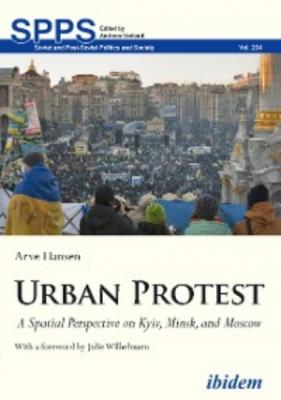Urban Protest. Arve Hansen
Чтение книги онлайн.
Читать онлайн книгу Urban Protest - Arve Hansen страница 8

The above three categories (form, motivation, waves) are not intended to be exhaustive, but to illustrate that “urban contention” is a multifaceted term with historic and contemporary relevance to most regions in the world. The following section serves two purposes: 1) to provide a justification for choosing Kyiv, Minsk, and Moscow as case studies for the three articles in this study; and 2) to show that space and protests are important factors which have affected, and continue to affect, the political situation in the East Slavic area.
2.2 Ukraine, Belarus, and Russia
Since this study is limited by a number of factors, such as time, funding, and space available, the project has been narrowed down geographically. The case studies are limited to the capital cities of Ukraine, Belarus, and Russia for three main reasons. Firstly, the three countries have many similarities. Secondly, despite these similarities, there are some interesting differences between the respective national opposition movements. Finally, two outside factors have pushed me to select these cases. I shall return to these shortly.
Furthermore, each case study has also been geographically limited to one or two urban public spaces, as the word limitations provided by the journal article format rarely allow for more. The choices and delimitations for each case study are discussed more thoroughly in each of the three chapters.
Similarities
Kyiv, Minsk, and Moscow are the capital cities of the countries often referred to as the Slavic Triangle (see e.g. Godin 2014), a term originating from the countries’ shared history. The territories of Ukraine, Belarus, and Russia each cover parts of Kievan Rus’ (pprox.. 882–1240), the Tsardom of Russia (1547–1722), and the Russian Empire (1722–1917), and they were all signatories to the Treaty of the Creation of the USSR in 1922, which was dissolved in 1991 by the collective decision of the three heads of state. In post-Soviet times, the three countries have struggled with many of the same obstacles: a brutal transition from planned to market economy, widespread corruption, autocratic leadership, popular discontent, etc. Moreover, there are strong ethnic, linguistic, cultural, political, architectural, economic, and criminal similarities and bonds between the three countries.
Figure 6: The Slavic Triangle (map)
[bad img format]
Map: Júlio Reis/Wikimedia Commons. Licensed under CC-BY-SA 3.0 (https://creativecommons.org/licenses/by-sa/3.0/deed.en) (edited by Arve Hansen)
Differences
However, the differences between the three countries are significant, too. Ukraine was one of the countries upended by a revolution in the 2000s, as the Orange Revolution of 2004–2005 resulted in regime change. Conversely, Belarus and Russia avoided becoming part of the wave of colour revolutions.7 This tendency repeated itself in the 2010s, as protests in Minsk and Moscow at the start of the decade all ended badly for the protesters,8 whilst the latest Ukrainian revolution of 2013–2014, centred on Maidan in downtown Kyiv, led to regime change for the second time in nine years.9 Today, protests continue to exert an influence on local and regional politics.10
Moreover, whereas the opposition in Kyiv has Maidan as an urban space designated for protest, the opposition in Minsk has very limited access to the city’s urban spaces; and in Moscow, although the authorities do allow protests, they carefully select which spaces to sanction for such actions, most probably to restrict the impact of the protests.
Outside factors
This study forms part of a research group studying Russian space (broadly understood to include Belarus and Ukraine).11 I have also lived in each country for an extended period of time (in Belarus, 2006–2010; in Ukraine, the first half of 2011 and 2013–2017; in Russia, 2011–2013). I thus have first-hand knowledge of, and a network of friends and acquaintances in, each of the three cities.
2.3 Relevance
Since prehistoric times, people have related by necessity to the intricacies of physical and social space, to the associations and emotions such spaces evoke, as well as to the possibilities and obstacles they provide. Even though our environment has changed, our basic human instincts are still active and, as in the prehistoric era, people congregate to discuss, deliberate, interact, and—in times of trouble—struggle together to find a solution to the problem.
The small selection of collective actions mentioned in this chapter demonstrates that urban mass protest can be a means of changing society, used by people across the world. With the spread of social media, waves of protest can expand with increased speed, and the Internet has facilitated the extension of protest movements, such as the colour revolutions, the Arab Spring, the Occupy movement, and the Yellow Vests. However, although the Internet is available in and used by the majority of the world’s population, people still use physical space in order to protest. This is because the presence of a group of people assembled at a focal point of the city serves a number of purposes that are rarely served by collective online action. A physical protest shows that there is discontent in the city, and that people are willing to sacrifice time and effort to come out in support of their cause.
I do not wish to undermine the power of the Internet as a tool for mobilising people to protest. Social media outlets clearly have several qualities suitable for facilitating and/or organising mass protest (see for example Herasimenka 2016).